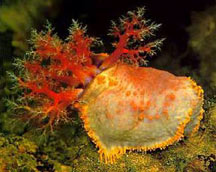Michael Paletta - Guest Author

Spiny Skin -
Echinoderms possess an interesting defensive structure called the pedicellaria. These external jaw-like structures are located not only on the ends of arms but are also found along the body. These structures help keep the multitude of larvae that are constantly looking for an attachment site from settling on the body surface of echinoderms. Furthermore, the external skeleton of most echinoderms is quite formidable, usually quite thick and hard containing spine, poison, toxic mucous or a combination of these.
Expulsion of internal organs -
A defensive behavior commonly demonstrated by sea cucumbers, echinoderms possess the ability to eject some of their internal organs when they feel threatened or stressed. Several other members of this phylum also utilize this defensive mechanism but to a lesser extent.
 When sea cucumbers are stressed either by being picked on by a fish or caught in a powerhead or pump, they will contract forcing out their digestive tract and a massive amount of tubules containing Holuthurin. This compound dramatically reduces the surface tension of water and it is hypothesized that this compound appears to inhibit the ability of fish to take in oxygen so they rapidly die when exposed to this toxin. This behavior is an attempt to get the offending party trapped in the filaments where it will suffocate, while the cucumber crawls away to regenerate a new digestive system. This compound is present in all of the sea cucumbers of the genus
Holothuria, which unfortunately make up most of the species commonly kept in aquaria.
Sea Apples, a close cousin of the sea cucumber, also possess a similar toxin that can kill all of the fish in an aquarium if it is disturbed.
When sea cucumbers are stressed either by being picked on by a fish or caught in a powerhead or pump, they will contract forcing out their digestive tract and a massive amount of tubules containing Holuthurin. This compound dramatically reduces the surface tension of water and it is hypothesized that this compound appears to inhibit the ability of fish to take in oxygen so they rapidly die when exposed to this toxin. This behavior is an attempt to get the offending party trapped in the filaments where it will suffocate, while the cucumber crawls away to regenerate a new digestive system. This compound is present in all of the sea cucumbers of the genus
Holothuria, which unfortunately make up most of the species commonly kept in aquaria.
Sea Apples, a close cousin of the sea cucumber, also possess a similar toxin that can kill all of the fish in an aquarium if it is disturbed.
Regenerative abilities -
Echinoderms use their regenerative abilities as a defensive mechanism, frequently utilized by
starfish when caught by an arm. When this happens, these animals will just drop off an arm and move away. The unwary attacker is left with a wiggling arm while the rest of the animal moves away to regenerate a new arm. This regenerative ability allows these animals to not only grow new appendages, but for some
cucumbers and
sea stars, it also allows entire new animals to be formed when the animal is split in two.
Part 3 of 8. Continue reading:
Part 1
Intro |
Part 2
Unique Chararcteristics |
Part 3
Unique Defense Chararcteristics |
Part 4
Sea Stars (Asteroidea) |
Part 5
Brittle & Serpent Starfish (Ophiuroidea) |
Part 6
Sea Cucumbers (Holothuroidea) |
Part 7
Sea Urchins (Echinoidea) |
Part 8
Feather Stars (Crinoidea) |
Biography
Michael Paletta is the author of two books, "The Modern Marine Aquarium" and "Ultimate Reefs," and has acted as a consultant with the National Aquarium in Baltimore and the Pittsburgh Zoo Aquarium. |




